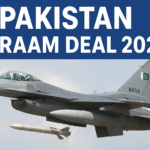Recently, Pakistan has been added to the list of buyers for the Advanced Medium-Range Air-to-Air Missiles (AMRAAM), a U.S.-made missile system used widely on fighter jets. The deal, involving Raytheon and the U.S. Department of War, represents a significant upgrade in Pakistan’s air defense capability. This article explains what AMRAAMs are, why this deal matters, the specifics of what Pakistan is getting, and the strategic and regional implications.
What Is AMRAAM (AIM-120)?
The AIM-120 AMRAAM (Advanced Medium-Range Air-to-Air Missile) is a modern, active-radar guided missile developed primarily by U.S. defense companies Hughes and Raytheon. Wikipedia+3U.S. Navy+3Air & Space Forces Magazine+3
Key characteristics:
- Beyond Visual Range (BVR): The missile can engage targets far beyond where the pilot can see visually. Wikipedia+2Air & Space Forces Magazine+2
- Active radar homing in terminal phase: After launch and midcourse updates via data link, the missile uses its own radar to locate and destroy the target. NAWCAD+2Air & Space Forces Magazine+2
- Multiple variants (A / B / C / D): Each successive version improves things like range, guidance, resistance to jamming, warhead performance, electronics. U.S. Navy+2Air & Space Forces Magazine+2
- Proven combat use: The AMRAAM has been used in real combat, and is one of the most established air-to-air missiles in allied inventories. Wikipedia+2Air & Space Forces Magazine+2
Because of those features, any air force that operates them gains the ability to engage enemy aircraft before they come close, use multiple missiles in engagements, and better counter electronic interference.
Details of the Deal & What Pakistan Gets
Here are the known facts about the agreement between Pakistan and the U.S.:
- Raytheon has a contract modification, adding Pakistan to the list of buyers for the AMRAAM missile system. Dawn+3Dawn+3Dawn+3
- The modification is valued at USD 41.6 million for production of the enhanced C8 and D3 variants of the missile. Army Recognition+3Dawn+3Dawn+3
- The overall contract value (with this addition) reaches about USD 2.5 billion. Dawn+3Dawn+3India Today+3
- The work under the contract is to be completed by around 2030. India Today+1
What this means for Pakistan:
- The missiles will be compatible with Pakistan’s fleet of F-16 aircraft. The F-16s already in service can carry AMRAAMs, which advantages a faster integration. Dawn+2Dawn+2
- Pakistan will likely receive the C8 and D3 variants—each variant brings certain advancements. For example, the C8 is export-approved, includes modern electronics refresh, better countermeasures; D3 brings further improvements in guidance and perhaps range. Army Recognition+2Air & Space Forces Magazine+2
- The deal does not clearly specify exactly how many missile units Pakistan will receive. India Today+1
Technical Strengths & Capabilities of AMRAAM C8 / D3
To understand why this acquisition matters, one must understand what improvements occur in these newer variants.
| Feature | Why It Matters |
|---|---|
| Better midcourse data link | Allows the launching aircraft or other platforms to update the missile on target movement, improving hit probability. Army Recognition+1 |
| Improved resistance to jamming / electronic warfare | Modern battlefields have strong electronic countermeasures. Enhanced electronics allow AMRAAM to better resist interference. Army Recognition+1 |
| Extended range (especially in favorable conditions) | Higher altitude launch or high-speed launch gives longer reach. This enables engaging threats before they get too close. Army Recognition+1 |
| Warhead & guidance improvements | More accurate target tracking, better proximity fuse, higher lethality. Army Recognition+1 |
These improvements collectively allow a more capable air defense posture. With improved reach and resistance to counter-measures, Pakistan Air Force (PAF) can better deter or respond to airborne threats.
Strategic Implications for Pakistan
Getting AMRAAMs is not just about basic missile power—it also has several strategic and geopolitical implications.
Deterrence & Air Superiority
- With AMRAAMs, PAF can extend its ability to engage enemy aircraft at longer ranges. This may act as a deterrent to potential air incursions.
- F-16s carrying modern AMRAAMs enhance their strike, intercept, and defensive capabilities. This improves the credibility of Pakistan’s air defense in crises.
Regional Balance
- In South Asia, air power is important. When one state strengthens its capabilities, others often perceive imbalance. The acquisition may prompt neighboring countries to adjust their defense plans.
- It may affect strategic calculus in potential aerial confrontations, patrols, or responses. Countries like India will monitor this.
Defense Diplomacy
- This deal signals improved military cooperation between Pakistan and the U.S. Given recent tensions and changes in foreign policy, this is an important diplomatic marker.
- It could open doors for further upgrades or joint development/licensing. Perhaps also shared training, logistics, or maintenance support.
Technology & Readiness
- Integrating advanced missiles demands supporting infrastructure: improved maintenance, radar systems, command & control, training for pilots and ground crew. Pakistan will need to ensure readiness.
- Ensuring secure supply lines, spare parts, and ongoing upgrades will be crucial. Variants like C8 / D3 need modern electronics, possibly newer radar and datalink capabilities.
Challenges & Considerations
Even though this is a strong deal, several challenges remain:
- Cost & Quantity Uncertainty
The contract amount is known, but the number of missiles is not. If Pakistan receives few units, the upgrade is more symbolic than transformative. - Operational Integration
- F-16s will need compatible avionics, radar targeting systems, datalinks.
- Pilots need training with the new missile’s performance envelope (range, flight profile, launch conditions).
- Maintenance, repair, and supply chains must support the newer parts and electronics.
- Dependence on Foreign Support
For spares, electronics, software updates, etc., Pakistan will depend on U.S. supply. Any diplomatic issues, sanctions, or export restrictions could affect sustainment. - Counter-measures & Evolving Threats
The adversary can develop or already uses advanced electronic warfare, stealth, or tactics to reduce effectiveness. Pakistan must continually improve detection, radar coverage, and ECCM (Electronic Counter-Counter Measures). - Political / Legal & Export Controls
U.S. export controls can restrict transfers of certain military tech. Also public perception domestically and regionally may vary; transparency and effective defense communication are needed.
What Other Countries’ Experience Shows
Looking globally, several air forces operate AMRAAM in similar and varied conditions.
- AMRAAM is used by over 40 countries. U.S. Navy+2Air & Space Forces Magazine+2
- Variants like AIM-120C and AIM-120D have been fielded with improved performance in range, guidance, resistance to jamming. Air & Space Forces Magazine+1
- Combat experience suggests that modern air-to-air missile performance often hinges not just on the missile but on good radar, early detection, pilot reaction time, and support systems. Adoption of AMRAAM without those supporting assets yields only partial advantage.
What to Watch Going Forward
To monitor how this development unfolds, here are the important signals:
- Public announcements of Pakistan Air Force training, test firings, or deployment of AMRAAM-C8 / D3 on operational F-16s.
- Radar, datalink, and avionics upgrades in PAF. These often accompany missile acquisitions to fully utilize modern missiles.
- Defense budget allocations over coming years—how much money goes toward maintenance, spares, and upgrades.
- Diplomatic or regional responses – whether neighboring countries respond with their own procurement or changes in policy.
Conclusion
The AMRAAM deal gives Pakistan a meaningful boost in its air combat capabilities. The acquisition of modern medium-range air-to-air missiles (C8 / D3 variants) promises better deterrence, more flexible response options, and greater interoperability for Pakistan’s F-16 fleet. But capability gains will depend not just on missiles alone—they must be accompanied by improved support infrastructure, training, radar systems, and consistent maintenance.
In a region where air domain dominance is vital, this upgrade could alter strategic balances. However, success will rely on execution. For Pakistan to truly harness the potential of AMRAAMs, careful planning, resource allocation, and continual modernization will be essential.











